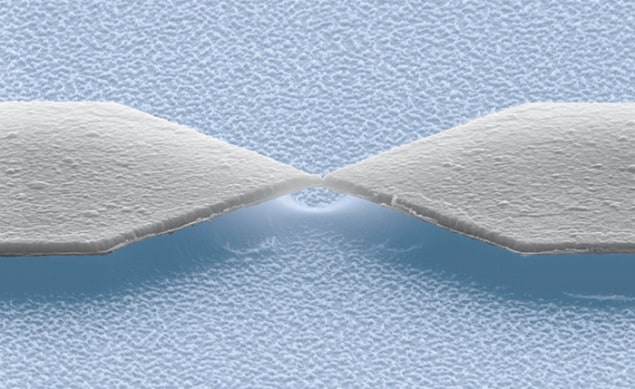
A single atom held between two sharp points has been used to create the smallest-ever memory device – according to the international team of researchers that built it. The aluminium atom operates as a two-terminal switch that can be toggled back and forth between two logical states. This is done by passing electrical currents through the atom, which results in tiny shifts in its position. The device could one day be used to create computer memories with extremely high density.
Conventional electronic switches are usually made of transistors that have three electrodes. The current flowing between two of the electrodes is controlled by applying a voltage to the third electrode. Nanometre-sized transistors based on one atom have been made before. However, the team says that its device is the first example of a single atom acting as a switch without the use of a gate electrode – the presence of which made previous devices much larger than one atom.
The device was made by researchers at the University of Konstanz in Germany and the Universidad Autónoma de Madrid in Spain. To make the switch, the team start with an aluminium wire just 1μm wide that is sitting on a flexible substrate. By gently bending the substrate, a break begins to form in the wire. The bending is stopped when the two sections are held together by just one atom at its narrowest part (see figure).
Distinct geometries
The switch is operated by sending a current through the single-atom contact. When the current is sent in one direction the switch is open and when the current is sent in the opposite direction the switch is closed. The open and closed switch positions correspond to the atom being in two different locations. These two distinct geometries have two different values of electrical conductance, which the team measured. These two values can be thought of as “0” and “1”, making the device able to store information.
“Our atomic contacts work as switches and non-volatile memories at the same time,” says one of the researchers, Juan Carlos Cuevas of Universidad Autónoma de Madrid. “Ideally, these memories could be used to replace the standard magnetic memories of our computers.”
The observation that alternating current made the switch open and close “first came as a surprise,” says team member Elke Scheer of the University of Konstanz.
Quantum interference
The big challenge for the team was to prove that the switch involved just one atom. To do this, the scientists cool their switch until the aluminium becomes a superconductor. Quantum mechanics governs the current that flows through the atomic-size wire and current-voltage characteristics in the superconducting state are sensitive to the quantum mechanical transport probabilities, which are determined by atomic positions. Since atomic contacts are so small, the conduction electrons behave as waves rather than as classical particles and the current is completely determined by quantum mechanical interference effects.
“The amazing part of our story is that we can determine how many wave functions carry the current in our switches and the probabilities for these waves to go through the contacts, which is something unique of our work,” says Cuevas.
“This is a very elegant experimental result,” says physicist Douglas Natelson at Rice University in Texas, who did not take part in the research. “It’s a great combination of techniques that provides detailed microscopic information that’s often difficult to obtain, such as the transmission coefficients of the quantum channels. That information is vital to establishing the remarkable fact that it is possible – at least under certain circumstances – to use current to toggle controllably between two particular atomic arrangements at the single-atom scale.”
Missing link
Physicist Jan van Ruitenbeek of Leiden University in the Netherlands, who was also not involved in the study, says that until now, the mechanism of the current’s effect on the atomic scale has not been understood: “Experiments that could probe [these] effects were simply missing and these results give us a first glimpse of what may be happening.”
At the moment, the switches can only function at cryogenic temperatures below 1 kelvin and clean-room lab conditions, where it is possible to limit atomic motion by freezing out the diffusion of metal atoms and thus stabilizing the switches for long periods of time. For potential future applications, the team says it will have to demonstrate that the devices can also work at room temperature, which could be challenging because metal atoms tend to diffuse around on surfaces. “Also, we would need to scale up the device to have millions of those switches working together in a macroscopic memory,” says Cuevas. But, he adds, “there are strategies to solve both problems and we believe that the applications will be possible in the near future, in 10 years or so.”
The research is described in Nature Nanotechnology 8 645.



